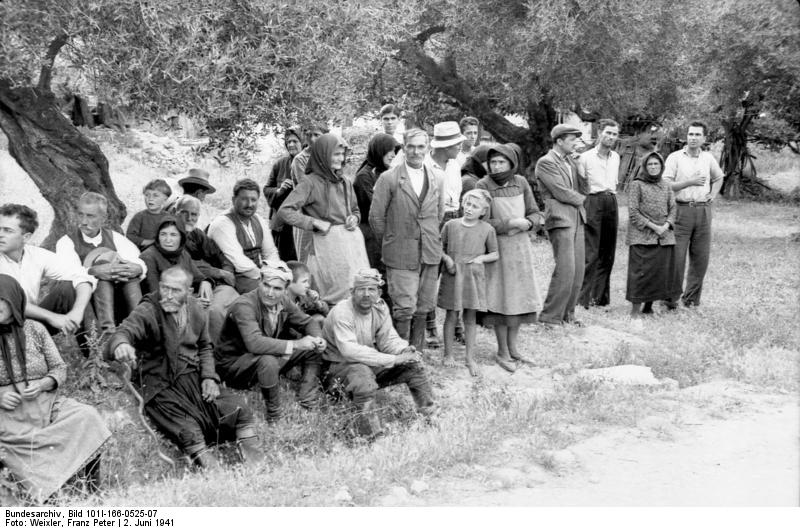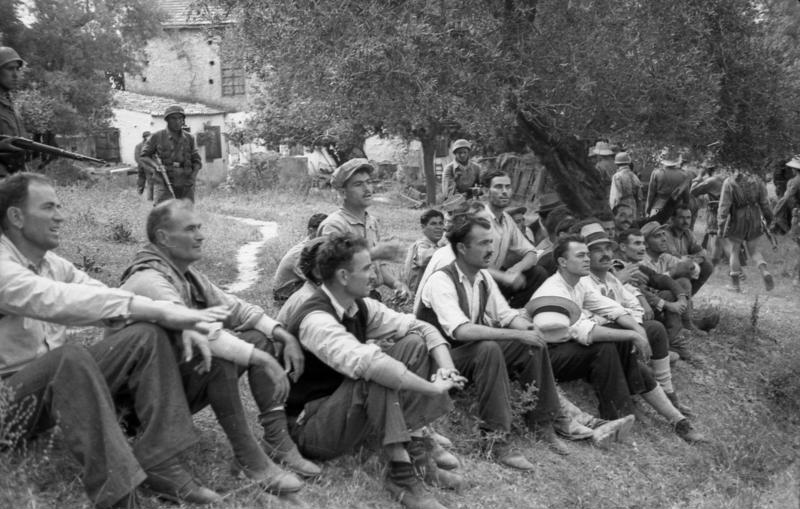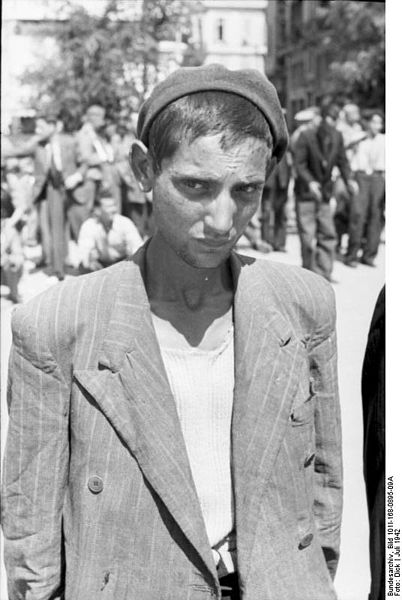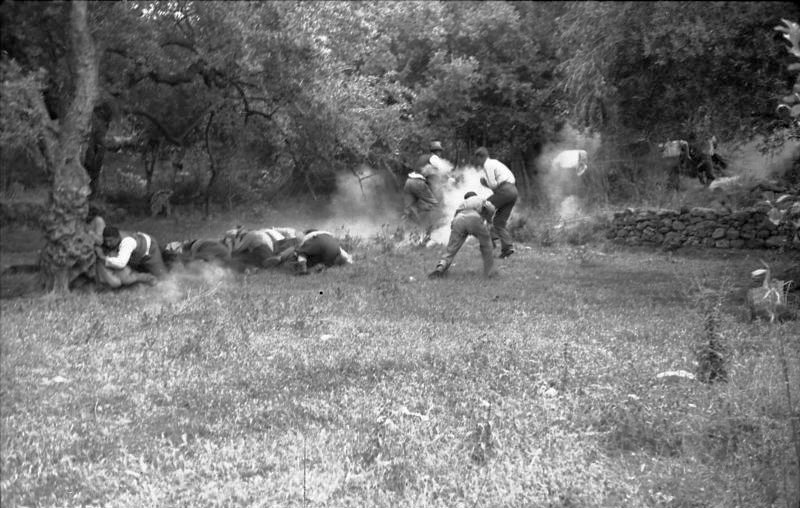.

Eye color examination for racial determination, Germany, 1936: photographer unknown (Deutsches Bundesarchiv)
But their eyes are all white, without lashes
and their arms thin as reeds.
Lord, not with these people. I've known
the voices of children at dawn
rushing down green slopes
happy as bees, happy as butterflies
with so many colours.
Lord, not with these people, their voices
don't even leave their mouths --
they stay glued to their yellow teeth.
Yours is the sea and the wind
with a star hung in the firmament.
Lord, they don't know that we are
what we are able to be
healing our wounds with herbs
found on the green slopes,
these slopes nearby, not any others;
that we breathe as we are able to breathe
with a little prayer each dawn
that reaches the shore by crossing
the chasms of memory --
Lord, not with these people. Let your will be done in another way.
and their arms thin as reeds.
Lord, not with these people. I've known
the voices of children at dawn
rushing down green slopes
happy as bees, happy as butterflies
with so many colours.
Lord, not with these people, their voices
don't even leave their mouths --
they stay glued to their yellow teeth.
Yours is the sea and the wind
with a star hung in the firmament.
Lord, they don't know that we are
what we are able to be
healing our wounds with herbs
found on the green slopes,
these slopes nearby, not any others;
that we breathe as we are able to breathe
with a little prayer each dawn
that reaches the shore by crossing
the chasms of memory --
Lord, not with these people. Let your will be done in another way.
11 September 1941
Detainee of German occupying forces, Saloniki, Greece, July 1942: photo by German Army war correspondent Dick (Deutsches Bundesarchiv)



German massacre of civilians, Kondomari, Crete, Greece, 2 June 1941: photos by German Army war correspondent Franz Peter Weixler (Deutsches Bundesarchiv)
May 1st parade, Germany, 1930s: photo by Paul Walde; image by Andreas Praefcke, 2005












12 comments:
In 1941, after the Nazi occupation of the Greek mainland, Seferis, serving as a press officer, accompanied the Greek government in exile -- first in Crete, then later, after the German invasion of Crete, in Egypt, where this poem was written (and later still, in South Africa)
The sequence photos in this post, made by Wehrmacht photographer Franz Peter Weixler, document the execution of male civilians from the village of Kondomari in Crete by an ad hoc firing squad made up of German paratroopers. The shooting, which occurred on 2 June 1941, was the first of an extended series of German mass reprisals in Crete.
Much to the dismay of his superiors, Franz-Peter Weixler's photos of the activities of the paratroopers on Crete got around. After the summer of 1941 Weixler was dismissed from the Wehrmacht for political reasons. Later he was accused of high treason for having leaked uncensored material, including these photos, and for having assisted civilians to flee the Terror in Crete.
Weixler composed a written report on the Kondomari massacre. His negatives from Kondomari survived. They were discovered in Deutsches Bundesarchiv files in the early 1980s.
Again, thank you. I really knew nothing of Seferis until this morning and realize that I should know more. The last line, which makes the poem into a prayer (“Lord, not with these people. Let your will be done in another way.”) is a very powerful and moving conclusion.
The poem, photographs and your historical account say everything. I found online and read the translation of the information Weixler provided in connection with Goering’s trial.
An odd thing I noticed is that the red wagon “float” in the bottom photo looks exactly like a Steuben Day Parade fixture I saw for years on Fifth Avenue in New York, which passed by a school I attended. Obviously, the wagon I saw wasn’t festooned with Nazi flags and the context made things entirely different. It’s one of New York’s nicest parades, actually, because the participants seem to clean up after themselves as they go along, which is helpful and unusual in comparison to the other Fifth Avenue celebrations.
Curtis, the photo was taken in Ochsenfurt, Germany. It is
a parade in the 1930s (probably on May 1st). The picture shows a carriage designed by the local "Sparkasse" bank.
The banal and worldly foundations of evil.
The photograph was made by Paul Walde (1899-1970).
His heirs released it into the public domain.
(It is the only one of these photos that does not come from the German Federal Archive -- which is, in my view, the most interesting of all historical archives, that is if one is interested in looking hard at the nature of the human beast, as reflected on its cultural surfaces... entirely literal, and seldom pretty. And too of course they had the best cameras so took the best photos, speaking, as we were just now, of craft and crafts...)
This chilling little four minute montage unfolds that day in Kondamari as the photographer saw it, evidently in horror of what he was seeing even as he preserved it for "history". The text of his report is intercut with the images.
The last photo in the montage shows the officer (then a lieutenant) who ordered the massacre.
Imagine if there had been a comparable act of recording and then revealing by a US military photographer at My Lai. Speaking as I was in a comment in the post above of history repeating.
The subject matter here is obviously serious, so it seems possibly frivolous to say that I really enjoyed the Shirley Bassey/Propellorheads clip. During her long distinguished career, Caroline worked for a long period as Dame Shirley's US record company publicist. Variety being the spice of life, Shirley Bassey activities varied greatly from those surrounding publicizing "baby bands" or established performers in other musical genres. The best part about it, however, was meeting Ms. Bassey's longtime music director, the late Arthur Greenslade, whose name I recognized as being the man who played piano on You Really Got Me. When I asked him about it, you could tell that he was pleased that someone knew about this pretty obscure aspect of his own long and distinguished career.
Of all the photographs you posted today, I think the top one, labeled "Eye color examination for racial determination, Germany, 1936", is the most disturbing. This is for all sorts of reasons. Naming them, I think, is unnecessary and would be insufficient.
Curtis,
The eye color determination photo seems a wonderful example of the banality of evil as well as of the blind imperviousness of the perpetrators to the meanings of what they are up to.
In my jaundiced white eyes this sort of thing -- the obdurate refusal of people inextricably caught up in history to recognize they are so caught -- hoves into view almost every time I venture feebly down the broken steps (which is less and less frequently, of late, with longer and longer intervals between timid defensive forays).
The Bassey/Propellorheads video is indeed compelling in many ways, principally, for me, in the manner in which the repetitions and syncopations of the video rhythm feed into the originating idea of historical recurrence. There's a nine minute version that further enhances these effects, thus underscoring the "message".
I always think of this when, as actually sometimes happens, somebody mentions that something that's happened before seems to be happening all over again.
(Lately a fellow who worships at the house of Gurdjieff keeps doing this. Once upon a time the sage of eternal recurrence used to be Nietzsche. Plus ça change... Indeed, the older one gets, the harder it is to pick out ANYTHING that has not happened before, and probably repeatedly. The smug confidence of those main frame computer ads I posted with "A Diary", a few days back, for example, remind me quite a bit of the smug confidence radiating from every current pitch for the latest new scraps of disposable commodity tech, whether Buzz or Twit or App or Face or I Me You Phone or whatever.)
Still, I think my favourite thing about the Bassey video is the facility of those cashmere studio technician types to slip into moonwalking and breakdancing.
But then the infamous Lieutenant Student, who issued the "Feuer!" command to the paratroopers at Kondamari, was doubtless adept at whatever proto-bebop rhythms were current among the Wehrmacht in 1941.
Eternal recurrence stipulates there be hip dudes in every historical cycle and for that matter probably also in every madhouse.
Oh good lord Tom.
My heart sinks on the reading/watching of 'well-documented' events as those in the village of Kondomari - so much that lately it has become really difficult to reclaim it. I am upon reading all of your words and watching the uploaded photographs moved beyond words reminded at the same time of one of the numerous massacres Kashmir has witnessed. Here is a wiki excerpt-
Wearing Indian Army fatigues to avoid detection, the killers came into the village in two groups at separate ends of the village where the two Gurdwaras were located. They first lined up the Sikhs, who had been celebrating the Holi and Hola Mahalla Festival, in front of their Gurdwaras and opened fire. 36 people were killed.
The sole survivor of the massacre was Nanak Singh, who was first saved by falling under someone who had been shot and then was wounded in the pelvis. Lying still and managing not to scream, which would have revealed his being alive, he recalled hearing the terrorists laughing over their deeds while sending a 'mission accomplished' message over their walkie-talkie. His sons Gurmeet Singh (16) and brother Darbari Singh (30) and three first cousins were among the dead. His oldest son was away at the time.
The Sikhs were singled out for the massacre, the village also had many Muslim and Hindus. Some of the Sikh widows spoke of their husbands being called out by name.
The village did not have a telephone, some boys who came on the scene had to run 7 km, over a mud road, to reach a phone and summon help.
And to think of the much awaited happy farmland endings
Every day we learn more about the seemingly inexhaustible capacity of humans to do evil.
Thank you for posting this. Curiously, those words of Seferis (in the excellent English translation by Keeley & Sherrard) came to me two weeks ago. The context was quite different: I was thinking about community and how individuals choose to isolate themselves from their communities. In our time we are suffering from the effects of isolation as well as intolerance.
I found myself framing a reply: "Why not with these people?" We all have the capacity to do good and evil. Disgusted as I am with what the Nazis did, I have to recognise that even war criminals can come to understand the value of life and to make amends for the evil they have done. It's a long, slow, painful process, but it is the path we must follow if we are to live together.
Rhonda,
Certainly it is easier to forgive and forget from a vantage of historical distance. Compassion calls forth compassion, and thus may bring change.
But -- seventy years ago, in that particular place, in those particular circumstances, the necessary distance on these matters might have been extremely hard to achieve.
To be human is to be human. That can occur and appear in different ways in different places on different occasions -- sometimes as a blessing, but alas also sometimes as a kind of hard curse.
Interesting in returning to this post some three years later to read Rhonda's comment again,
"I have to recognise that even war criminals can come to understand the value of life and to make amends for the evil they have done. It's a long, slow, painful process, but it is the path we must follow if we are to live together."
This seems so wise, so hopeful.
I couldn't help thinking of the war crimes of our present time, some of them, with a terrible irony, conducted under the hideous "hasbara shield" that insults the sufferings of the victims of 1930s nazism by using them as an excuse for the inexcusable.
I refer to the incredibly cynical refusal of the IOF to accept any responsibility for its war crimes in Gaza, which evoked measured but stern condemnation from Ban Ki-moon.
Among the specific transgressions for which Ban Ki-moon suggested the IOF ought to be held responsible were the attacks on UN schools.
When the UN dared point out to the world that, despite the diligent (and of course absolutely necessary) reiterated specifications of coordinates of schools being used as sanctuary for homeless refugees, in messages to the invading forces, eight of those schools were directly attacked, causing unspeakable carnage among innocent civilians, most of them children and women, the IOF repeatedly "declined comment".
And now, to head off the eventuality of a war crimes tribunal, the guilty party, true to their standard operating procedure, already have a discreditation campaign underway -- against, of all people, Ban Ki-moon and the UN.
The American billionaire casino mogul Sheldon Adelson funds an aggressive PR campaign conducted by Rabbi Shmuley Boteach of This World: The Values Network; on Labor Day, this group bought a full page pro-Israel ad in the New York Times, with a sort of "Wanted" photo of Ban Ki-moon smack in the centre.
The punish-the-victim strategy we are seeing at work here suggests that far from showing any sense of remorse toward the society they have torn to bits, these murderers are standing on the dead and maimed bodies, beating on their breasts like baby King Kongs in continuous tantrum, and threatening worse retribution in future against anyone who might be so reckless as to stand in their way.
In short, then, history seems to be telling us that the perpetrators of historical evil are extremely unlikely to be brought to any sort of reckoning without more kicking and screaming then this fragile and battered world can presently put up with.
So, much as one might wish to see the miraculous birth of some new compassion out of this pit of pain and ruin, in fact I fear what we are actually seeing and will actually be seeing amount to nothing but a strong promise of more of same.
Post a Comment